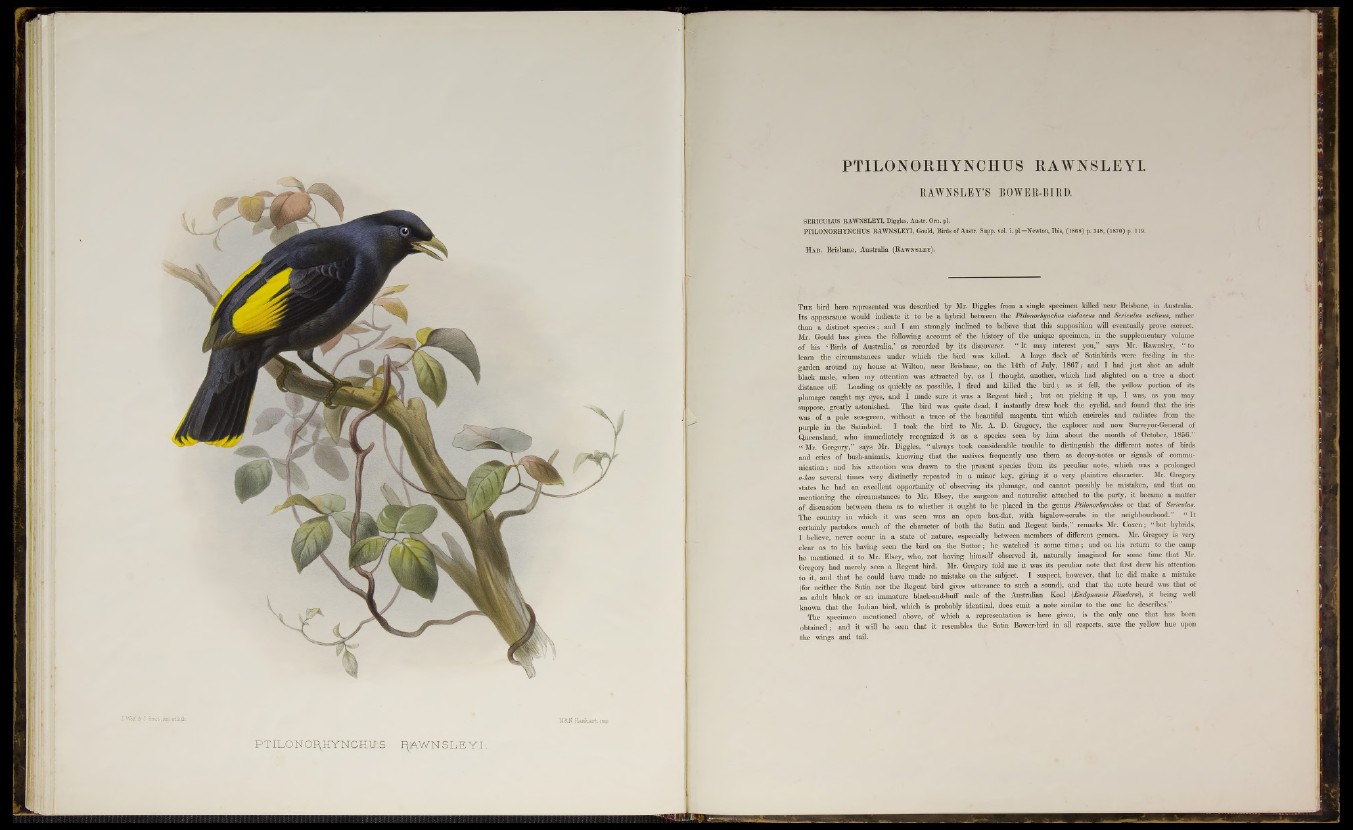
M&N Haiihart. imp
P TILO N OT\H YNCHU: S F^AWN S L E Y I .
PTILONORHYNCHUS RAWNSLEYI.
RAWNSLEY’S BOWER-BIRD.
SERICULUS RAWNSLEYI, Diggles, Austr, Oro. pi.
PTILONORHYNCHUS RAWNSLEYI, Gould, Birds o f Austr. Supp. toL i. pL—Newton, Ibis, (1 868) p. 348, (1870) p. 119.
H a b . Brisbane, Australia (R a w n s l e y ) .
T h e bird here represented was described by Mr. Diggles from a single specimen killed near Brisbane, in Australia.
Its appearance would indicate it to be a hybrid between the Ptilonorhynchus violaceus and Sericulus melinus, rather
than a distinct species; and I am strongly inclined to believe that this supposition will eventually prove correct.
Mr. Gould has given the following account of the history of the unique specimen, in the supplementary volume
of his ‘Birds of Australia,’ as recorded by its discoverer. “ It may interest you,” says Mr. Bawnsley, “ to
learn jfche circumstances under which the bird was killed. A large flock of Satinbirds were feeding in the
garden around my house at Wilton, near Brisbane, on the 14th of July, 1867; and I had just shot an adult
black male, when my attention was attracted by, as I thought, another, which had alighted on a tree a short
distance off. Loading as quickly as possible, I fired and killed the bird; as it fell, the yellow portion of its
plumage caught my eyes, and I made sure it was a Regent bird ; but on picking it up, I was, as you may
suppose, greatly astonished. The bird was quite dead, I instantly drew back the eyelid, and found that the iris
was of a pale sea-green, without a trace of the beautiful magenta tint which encircles and radiates from the
purple in the Satinbird. I took the bird to Mr. A. D. Gregory, the explorer and now Surveyor-General of
Queensland, who immediately recognized it as a species seen by him about the month of October, 1856.”
“ Mr. Gregory,” says Mr. Diggles, “ always took considerable trouble to distinguish the different notes of birds
and cries of bush-animals, knowing that the natives frequently use them as decoy-notes or signals of communication;
and his attention was drawn to the present species from its peculiar note, which was a prolonged
o-hao several times very distinctly repeated in a minor key, giving it a very plaintive character. Mr. Gregory
states he had an excellent opportunity of observing its plumage, and cannot possibly be mistaken, and that on
mentioning the circumstances to Mr. Elsey, the surgeon and naturalist attached to the parly, it became a matter
of discussion between them as to whether it ought to be placed in the genus Ptilonorhynchus or that o f Sericulus.
The country in which it was seen was an open box-flat, with bigalow-scrubs in the neighbourhood.” “ It
certainly partakes much o f the character o f both the Satin and Regent birds,” remarks Mr. Coxen; . “ but hybrids,
I believe, never occur in a state of nature, especially between members of different genera. Mr. Gregory is very
dear as to his having seen the bird on the Suttor; he watched it some time; and on his return to the camp
he mentioned it to Mr. Elsey, who, not having himself observed it, naturally imagined for some time that Mr.
Gregory had merdy seen a Regent bird. Mr. Gregory told me it was its peculiar note that first drew his attention
to it, and that he could have made no mistake on the subject. I suspect, however, that he did make a mistake
(for neither the Satin nor the Regent bird gives utterance to such a sound), and that the note heard was that of
an adult black or an immature black-and-buff male of the Australian Koel (Eudynamis Flindersi), it being well
known that the Indian bird, which is probably identical, does emit a note similar to the one he describes.”
The specimen mentioned above, of which a representation is here given, is the only one that has been
obtained; and it will be seen that it resembles the Satin Bower-bird in all respects, save the yellow hue upon
the wings and tail.